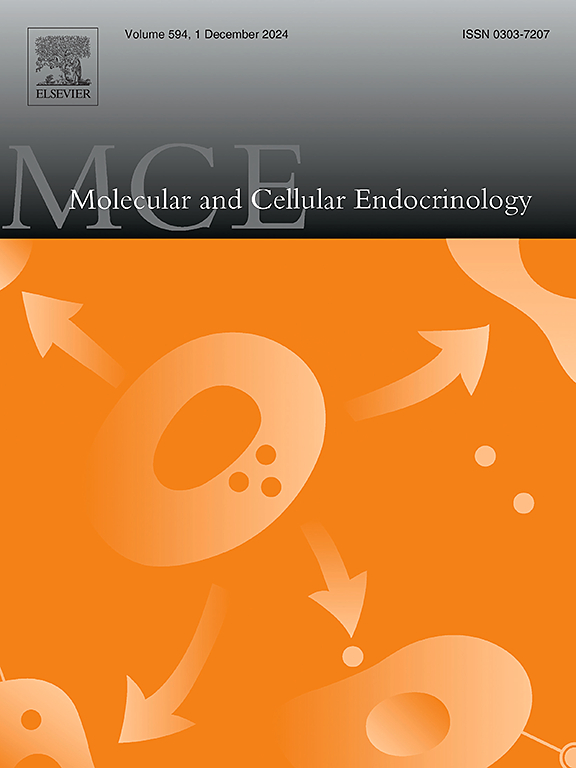Exploratory analysis of differences at the transcriptional interface between the maternal and fetal compartments of the sheep placenta and potential influence of fetal sex
IF 3.6
3区 医学
Q2 CELL BIOLOGY
引用次数: 0
Abstract
An understanding of the inner workings of the placenta is imperative to elucidate how the maternal and fetal compartments coordinate to mediate fetal development. The two compartments can be separated and studied before term in sheep, a feat not possible in humans, thus providing a valuable translational model. This study investigated differential expression of gene signaling networks in the maternal and fetal compartments of the placenta and explored the potential influence of fetal sex. On approximately gestational day 120 (term: 147 days), ewes were euthanized and fetuses removed and sexed. Placentomes [n = 5 male, n = 3 female] were collected, and caruncles (maternal) and cotyledons (fetal) were separated and sequenced to assess RNA expression. Analysis revealed 2627 differentially expressed genes (FDR<0.01, abslog2FC ≥ 2) contributing to key transcriptional differences between maternal and fetal compartments, which suggested that the maternal compartment drives extracellular signaling at the interface whereas the fetal compartment controls internal mechanisms crucial for fetal-placental development. X-chromosome inactivation equalized expression of a vast majority of X-linked genes in the fetal compartment. Additionally, the female placenta had more fine-tuned regulation of key pathways for fetal-placental development, such as DNA replication, mRNA surveillance, and RNA transport, compared to males, which had enrichment of metabolic pathways including TCA cycle and galactose metabolism. These findings, in addition to supporting differences in expression in the maternal and fetal placental compartments and the possible influence of fetal sex, offer a transcriptional platform to compare placental perturbations that occur at the maternal-fetal interface that contribute to adverse pregnancy outcomes.

绵羊胎盘母体和胎儿间转录界面差异的探索性分析及胎儿性别的潜在影响
了解胎盘的内部工作是必要的,以阐明如何协调母婴室介导胎儿发育。这两个隔室可以在绵羊中分离并在足月前进行研究,这在人类中是不可能的,因此提供了一个有价值的转化模型。本研究研究了胎盘母室和胎室中基因信号网络的差异表达,并探讨了胎儿性别对其的潜在影响。大约在妊娠第120天(足月147天),对母羊实施安乐死,取出胎儿并进行性别鉴定。收集胎盘虫[雄性5只,雌性3只],分离腕骨(母体)和子叶(胎儿)并测序以评估RNA表达。分析显示,2627个差异表达基因(FDR<0.01, abslog2FC≥2)导致了母胎室之间的关键转录差异,这表明母胎室驱动界面的细胞外信号传导,而胎儿室控制胎儿-胎盘发育的关键内部机制。x染色体失活使胎儿室中绝大多数x连锁基因的表达相等。此外,与男性相比,女性胎盘对胎儿-胎盘发育的关键途径(如DNA复制、mRNA监视和RNA运输)具有更精细的调控,而男性则具有丰富的代谢途径,包括TCA循环和半乳糖代谢。这些发现,除了支持母体和胎儿胎盘室的表达差异和胎儿性别的可能影响外,还提供了一个转录平台来比较发生在母胎界面的胎盘扰动,这些扰动会导致不良妊娠结局。
本文章由计算机程序翻译,如有差异,请以英文原文为准。
求助全文
约1分钟内获得全文
求助全文
来源期刊

Molecular and Cellular Endocrinology
医学-内分泌学与代谢
CiteScore
9.00
自引率
2.40%
发文量
174
审稿时长
42 days
期刊介绍:
Molecular and Cellular Endocrinology was established in 1974 to meet the demand for integrated publication on all aspects related to the genetic and biochemical effects, synthesis and secretions of extracellular signals (hormones, neurotransmitters, etc.) and to the understanding of cellular regulatory mechanisms involved in hormonal control.
 求助内容:
求助内容: 应助结果提醒方式:
应助结果提醒方式:


